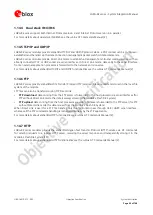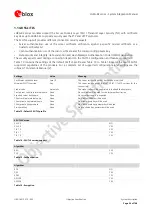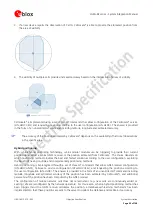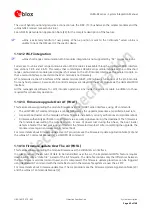
LARA-R2 series - System Integration Manual
UBX-16010573 - R02
Objective Specification
System description
Page 45 of 148
The “wake-up via data reception” feature cannot be disabled.
In command mode
11
, with “wake-up via data reception” enabled and autobauding enabled, the DTE
should always send a dummy character to the module before the “AT” prefix set at the beginning of each
command line: the first dummy character is ignored if the module is in active-mode, or it represents the
wake-up character if the module is in low power idle-mode.
In command mode
, with “wake-up via data reception” enabled and autobauding disabled, the DTE
should always send a dummy “AT” to the module before each command line: the first dummy “AT” is
not ignored if the module is in active-mode (i.e. the module replies “OK”), or it represents the wake up
character if the module is in low power idle-mode (i.e. the module does not reply).
Additional considerations
If the USB is connected and not suspended, the module is kept ready to communicate over USB regardless the
AT+UPSV settings, which have instead effect on the UART behavior, as they configure the UART power saving,
so that UART is enabled / disabled according to the AT+UPSV settings.
To set the AT+UPSV=1, AT+UPSV=2 or AT+UPSV=3 configuration over the USB interface, the autobauding must
be previously disabled on the UART by the +IPR AT command over the used USB AT interface, and this +IPR AT
command configuration must be saved in the module’ non-volatile memory (see the
u-blox AT Commands
Manual
[2]). Then, after the subsequent module re-boot, AT+UPSV=1, AT+UPSV=2 or AT+UPSV=3 can be issued
over the used AT interface (the USB): all the AT profiles are updated accordingly.
1.9.1.5
Multiplexer protocol (3GPP TS 27.010)
LARA-R2 series modules include multiplexer functionality as per
3GPP TS 27.010
[8], on the UART physical link.
This is a data link protocol which uses HDLC-like framing and operates between the module (DCE) and the
application processor (DTE) and allows a number of simultaneous sessions over the used physical link (UART): the
user can concurrently use AT interface on one MUX channel and data communication on another MUX channel.
The following virtual channels are defined (for more details, see
Mux implementation Application Note
Channel 0: Multiplexer control
Channel 1 – 5: AT commands / data connection
Channel 6: GNSS data tunneling
The GNSS data tunneling channel is not supported by “02” product versions.
11
See the
u-blox AT Commands Manual
[2] for the definition of the command mode, data mode, and online command mode.
















































